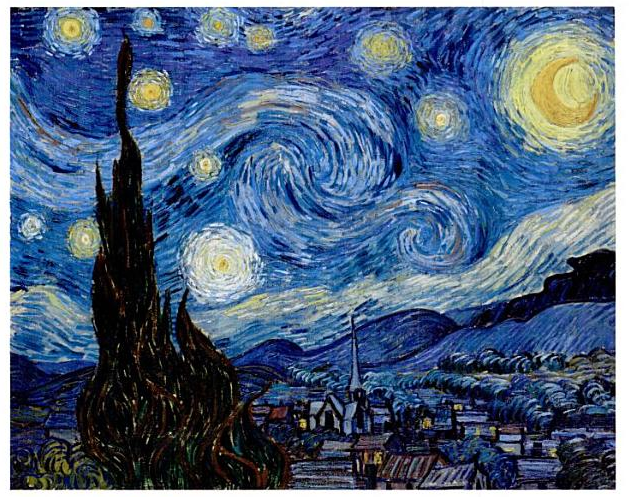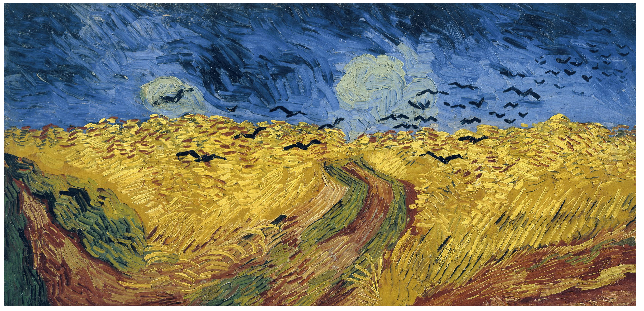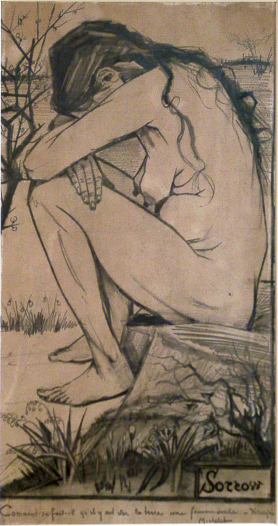Vincent van Gogh is now viewed as a representative of post-impressionist school of painting. However, one can say that his style evolved significantly during his life-time and there is a significant difference between his later and earlier works.
This paper is aimed at discussing the picture illustrating the changes in his artistic technique. At first close attention should be paid such paintings as The Starry Night and Wheatfield with Crows that throw light on his style that he developed at the end of his life.
Moreover, these painting should be compared to his drawing known as Sorrow. These pictures should be analyzed in terms of such criteria as the use of lines, shape, color, value, space, texture, and form because they are important elements of art. It seems that this comparison illustrate the transformation of van Gogh’s painting.
First, it should be noted that The Starry Night was created when van Gogh was staying at Saint-Paul Asylum in Saint-Rémy (Thomson 3). At that time, van Gogh was trying to maintain his psychological balance, but at the same time he wanted to develop his artistic style (Thomson 3).
During this period, van Gogh created numerous masterpieces that are still of great interest to art historians and critics. The Starry Night is probably the most famous painting that he created at Saint-Paul Asylum. One of the elements that attract attention is the rich texture of this of this work.

(Figure 1: Vincent van Gogh as cited in Thomson 2)
By laying paint very thickly, van Gogh makes the painting resemble an engraving or etching. This technique is called impasto and it was widely adopted by impressionist painters (Buser 195).
The viewers can also notice that in this work, the artist uses mostly curves, rather than straight lines, and he does not want to create pure geometric forms. Another criterion that should be taken into account is van Gogh’s use of colors. It is also important to mention that van Gogh combines white and yellow colors when depicting the light of stars.
Another distinctive characteristic of The Starry Night is the value or the combination of light and dark colors. As a rule, dark colors dominate those painting in which a night landscape is depicted. However, one cannot say the same thing about this work of art, because the painter gives preference to light colors, especially yellow and white.
This is a distinguishing trait of this work. Apart from that, van Gogh creates very unusual shapes and forms in this picture. The author extensively uses curves and it seems that he tries to depict a vortex in the sky. Van Gogh chooses mostly asymmetrical and irregular shapes and forms in order to emphasize the unpredictability of nature.
Finally, one should remember about the author’s sense of space. It should be noted that the artists places the starry sky in the very center of the painting while the town that he depicts is not of great importance to him, even though it is located in the foreground of the picture.
Apart from that, the space of this picture is not symmetrical, and it is difficult to distinguish a background and foreground. One can argue that Van Gogh does not attempt to create an illusion of three-dimensional space because he pays more attention to the palette of the painting.
This is one of the arguments that one can make while discussing this famous image. This image is probably the most famous work that van Gogh created during his stay at Saint-Paul Asylum.
There are other paintings that illustrate the development of van Gogh’s artistic style, and one of them is Wheatfield with Crows. Van Gogh created it after he left Saint-Paul Asylum in 1890 (Mancoff 89). It is believed to be the final work completed by this artist (Mancoff 89).
This is one of the reasons why this picture is worth attention. To a great extent, it resembles The Starry Night. For instance, the author creates a very rich texture by using thick layers of paint. As it has been said before, such a technique as impasto plays an important role for van Gogh.

(Figure 2: Van Gogh, The Starry Night, as cited in Mancoff 89)
Additionally, one should mention that the author juxtaposed dark and light colors, and they create a horizontal divide of the painting. It should also be noted that the space of his painting has a distinct background and foreground; in particular, one can speak about the evening sky and the field.
The author creates a very bright yellow color when depicting the field, and it is rather unusual if one takes into account that van Gogh describes a night scenery.
Apart from that, this picture incorporates numerous curves while it is very difficult to find any straight lines. In this way, the author depicts asymmetrical and irregular patterns. These are the most distinctive peculiarities of this picture.
On the whole, these paintings differ dramatically from the earlier works created by van Gogh. For instance, one can look at the drawing known as Sorrow. It depicts van Gogh’s model and mistress called Sien who later committed suicide (Charles 25).
The biographers of van Gogh and art historians believe that she was a prostitute who he met in the Hague (Charles 25). The author did this work long before his death, and at that time, he was only experimenting with different styles and techniques (Charles 25).
The viewers can immediately notice Van Gogh often uses straight lines and this technique is not typical of his later works. Moreover, the artist creates a detailed depiction of Sien’s body, and viewers can see that she is pregnant. At the end of his career, van Gogh did not pay close attention to the physical characteristics of people he portrayed.

(Figure 3: Van Gogh, Sorrow as cited in Charles 25)
Moreover, he does not try to divide space into a foreground and background. The figure of Sien occupies the entire space of the drawing. The author does not experiment with colors because at the time when he was working on this drawing. Probably, at that time the artist had not yet developed his unique vision of color.
However, this work of art still produces a powerful impression on the viewer because van Gogh manages to show Sien’s suffering and her sense of despair. This is why one cannot disregard it because this work is also a significant of van Gogh’s legacy.
Overall, these examples show that Vincent van Gogh’s artistic works vary significantly in terms of artistic techniques. Although he is now believed to be a post-impressionist painter, the earlier works of this artist do not have the distinctive characteristics of this artist’s style, especially his rich palette.
In turn, The Starry Night and Wheatfield with Crows are the final works of this painter and they demonstrate his artistic progress.
Works Cited
Buser, Thomas. Experiencing Art Around Us, New York: Cengage Learning, 2006. Print.
Charles, Victoria. Vincent van Gogh, London: Parkstone International, 2011. Print
Mancoff, Debra. Van Gogh’s Flowers, Boston: Frances Lincoln Ltd, 2008. Print.
Thomson, Richard. Vincent Van Gogh: The Starry Night, New York: The Museum of Modern Art, 2008. Print.